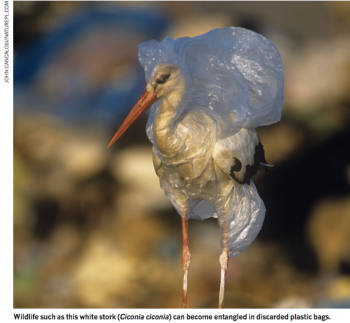“An international group of scientists, including the young Chelsea Rochman and Mark Anthony Browne from California, with the support of the veteran marine scientist Richard Thompson from the UK and a host of others from the USA and Japan, has called on policy-makers to classify plastic waste as hazardous waste.
“Their argument, published in the latest issue of Nature, states that classifying plastic waste as hazardous waste is not only a more accurate description of its toxic activities, but will also allow effective action to be taken against such harms. Note that they are not calling for the end of plastics – though they target PVC, polystyrene, polyurethane and polycarbonate as the most hazardous of the hazards – but for a more rigorous infrastructure that comes with a new classification.
http://discardstudies.wordpress.com/2013/02/15/scientists-call-to-classify-plastic-waste-as-hazardous-waste/
Plastics waste is clearly hazardous when it finds its way to an inappropriate place. That should never happen, but of course it does, in vast quantities and seemingly without any sign of reduction. Once ‘out there’, perhaps unseen save for the “witches knickers” flapping in the wind, we tend to forget, to turn our eyes away from the problem and carry on regardless. This cannot continue.
Any possibility for new or improved legislation that may move toward classification of plastics waste as hazardous waste will cause widespread concern and almost certainly increase costs, though the justification for those cost increases might be rather difficult to justify.
The problem is one of focus. How to constrain and, if necessary to punish, the offenders without impeding the activities of those who are happy to segregate their plastic waste for kerbside collections and others who perform well at any stage in the disposal chain through treatment to reuse or recycling, even to disposal where unavoidable?
How does this impact on the clinical waste sector? Separation and recovery of plastics from ATT-treated wastes is still resisted by individuals at the Environment Agency who seek to maintain an existing and unsteady playing field, tinkering with matters entirely outwith their scope of responsibility. Leaving that aside, at least temporarily, careless crafting of future legislation may impact greatly on those processing clinical wastes and seeking to landfill mixed plastic-rich floc.
Landfill should be avoided. There are several alternatives – cement kilns are the most frequently quoted option but this rarely happens as the amount of waste is too small. Now, with the rapid expansion of W2E plants across the UK, many of which are planned without clear evidence of sufficient feedstock available to operate them successfully, this seems to be the ideal option for autoclave, microwave and other treatment residues for clinical and sanitary/offensive wastes.
This will be environmentally sound, and will undoubtedly be preferable to landfill disposal. The regulatory stance must change, to acknowledge the errors that place barriers in place for this disposal option, opening the way to materials or resource recovery from treated wastes via materials recovery or at W3E plants
Remember, you heard it first on the Clinical Waste Discussion Forum.
